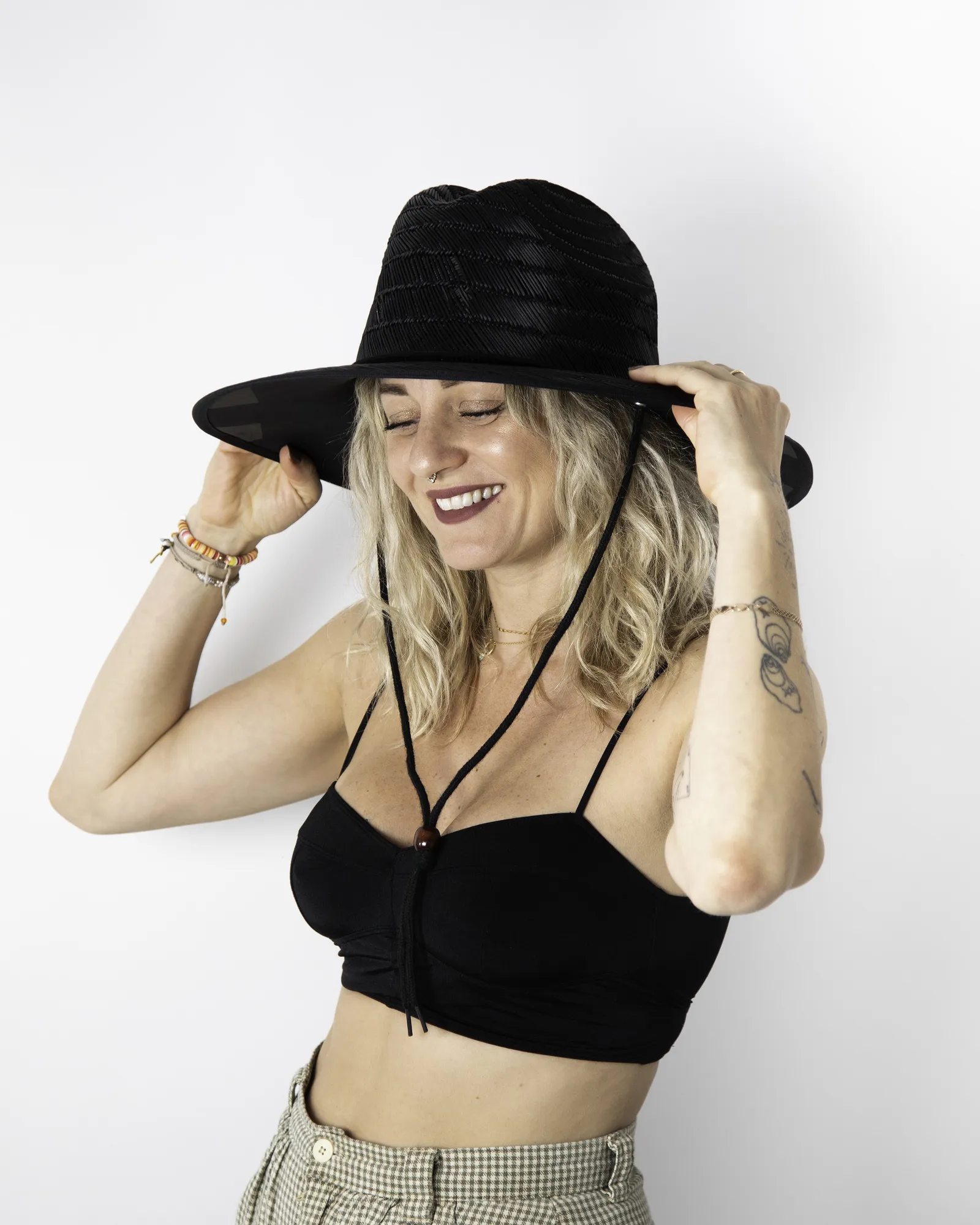Why get a straw hat for summer?
- Home
- Custom hats
- Straw hats
- Why get a straw hat for summer?

Straw hats: Natural comfort for summer heat
When the summer sun beats down, most people reach for sunscreen and sunglasses. But true sun protection goes beyond these basics. Straw hats offer protection with a side of style that alternatives cannot match.
Discover why straw hats deserve a prominent place in your next promotional product campaign and how these natural fibers benefit your health and our environment.
Key Takeaways
The natural advantage of straw
Straw is a renewable resource with deep historical roots. Unlike synthetic alternatives, straw:
- Comes from renewable plant sources that grow much faster than the trees used for other natural materials.
- Requires less intensive processing than plastic-based synthetic hats.
- Biodegrades naturally.
- Provides natural breathability through its woven structure.
- Offers flexibility and lightness.
- Contains no artificial chemicals that commonly cause skin irritation.
What are straw hats made of?
Straw hats are made of wheat straw, rice straw, palm leaf fronds, and seagrass. Each brings unique characteristics to the final product, from the lightweight design flexibility of wheat straw to the durability of palm leaves.
Some straw hat materials, like wheat and rice straw, come from agricultural byproducts after grain harvesting. Using these plant materials gives purpose to what would otherwise become waste. Premium materials such as toquilla palm (used for authentic Panama hats) are specifically cultivated for hat production.
Many traditional straw hats still incorporate artisanal techniques that require less energy-intensive manufacturing than synthetic alternatives. This handcrafted approach results in unique variations that mass production cannot replicate.
The sun protection varies depending on the weave tightness and brim width. Tightly woven premium straw hats with wide brims provide substantial sun protection, though specific UPF ratings depend on the individual hat construction.
Environmental impact of straw hat production
Most straw hat materials come from agricultural byproducts that would otherwise go to waste. Using these materials diverts waste from being burned in fields, a practice that contributes to air pollution.
The traditional production process for straw hats requires minimal machinery and often relies on skilled artisan techniques passed down through generations. This low-tech approach translates to reduced carbon emissions during manufacturing.
Water usage for straw hat production remains minimal compared to synthetic hats. The plants that provide straw typically grow with natural rainfall rather than irrigation, further reducing the environmental impact.
The summer benefits of straw hats
The practical advantages of straw hats make them ideal companions for summer activities:
- Sun protection: A wide-brimmed hat provides up to UPF 50+ protection and blocks harmful UV rays from your face, neck, and ears.
- Temperature regulation: The natural ventilation of woven straw keeps your head cool even in intense heat.
- Packability: Quality straw hats bounce back from being packed in luggage or beach bags, maintaining their shape for years with proper care.
- Versatility: From casual beach outings to formal summer weddings, the right straw hat complements any occasion with natural elegance.
- Lightweight comfort: Straw hats weigh significantly less than fabric or leather alternatives. You can wear them all day without head fatigue.
- Natural moisture absorption: Straw fibers absorb perspiration without becoming waterlogged. Your forehead stays dry during hot activities.
- Distinctive appearance: Each straw hat carries unique natural variations in color and texture that mass-produced synthetic hats cannot replicate.
Popular straw hat styles for every occasion
The right straw hat style for your needs makes all the difference in both comfort and style:
- Fedoras: This medium-brim classic with its distinctive crown pinch is good for semi-formal events. The straw fedora hats bring sophistication to summer garden parties and outdoor weddings without the heaviness of felt versions.
- Cowboy straw hats: Western-inspired designs offer practical protection with cultural flair. These structured hats feature shaped crowns and sturdy construction that stands up to regular outdoor use.
- Wide-brimmed straw hats: The quintessential beach vacation companion features extra-wide brims (4+ inches) that create mobile shade zones. These practical styles often have chin straps for windy conditions.
- Panama hats: This classic features lightweight toquilla palm fibers woven so finely that the hat rolls up for travel. The traditional Panama works for casual and business settings with its breathable yet refined appearance.
- Boaters: This flat-crowned, stiff-brimmed style evokes a timeless style. Originally worn for boating and outdoor activities, these structured hats pair perfectly with summer suits and warm-weather formal attire.
- Lifeguard straw hats: These rugged, wide-brimmed workhorses use thicker straw with looser weaves for maximum ventilation. Their distinctive shape provides 360-degree sun protection for outdoor professionals and beach enthusiasts.
Check out our collection of straw hats that you can personalize with your brand’s unique colors, logos, and design elements!
Cultural heritage in every weave
Straw hats connect us to traditions that span continents and centuries. Panama hats, contrary to their name, originated in Ecuador, where skilled artisans still craft them using toquilla palm through techniques UNESCO recognizes as Intangible Cultural Heritage.
The iconic American boater hats gained popularity in the early 20th century and became synonymous with summer social events.
The Mexican sombrero is one of the most recognizable straw hat styles globally. Traditional sombreros feature tightly woven palm leaf fibers with wide brims that provide exceptional sun protection for agricultural workers.
The Italian paglietta, a flat-topped straw boater with ribbon trim, became the signature hat of Venetian gondoliers and later spread throughout Mediterranean coastal regions.
The Asian conical hat, known as nón lá in Vietnam and dǒulì in China, demonstrates remarkable engineering with its simple yet effective design. Crafted from palm leaf or wheat straw, these hats shed rain, block the sun, and provide air circulation through a center opening. Some Vietnamese versions even contain poems or messages visible only when held up to light.
These cultural connections add depth to straw hats beyond their practical benefits. By choosing straw headwear, you participate in the continuation of craft traditions that support communities of skilled artisans worldwide.
How to care for a straw hat
If you decide to add a straw hat to your summer rotation, make it last. To maximize the lifespan of a straw hat:
- Store it upside down on its crown or on a hat rack to preserve the brim shape.
- Brush off dust and debris with a soft brush.
- Remove water spots by lightly rubbing with a damp cloth, then allowing to air dry.
- Keep away from prolonged direct sunlight when not wearing.
- Apply a light mist of cool water for shape restoration on hot, dry days.
With proper care, a quality straw hat lasts for many summers, it is an environmentally and economically sound choice.
The future of sustainable headwear
As consumers become more environmentally conscious, the demand for natural materials like straw continues to grow. Innovations in straw hat manufacturing now include water resistance derived from natural waxes and improved weaving techniques for greater durability.
Some forward-thinking business brands implement closed-loop systems where spent straw hats can return to the manufacturer for composting or incorporation into new products. This approach creates a circular economy model that minimizes waste.
Make the switch to straw this summer with Anthem Branding
Straw hats combine form, function, and environmental responsibility. Their natural materials provide superior comfort during hot weather, their traditional construction techniques support artisanal communities, and their biodegradable nature leaves a lighter footprint on our planet.
Next time you shop for summer hats, check out the humble yet sophisticated straw hat. Your choice supports sustainable materials, cultural heritage, and practical sun protection that plastic alternatives cannot match.
Ready to explore the world of custom headwear? Contact Anthem Branding to discover our selection of customizable, eco-friendly straw hats that make a statement about your brand’s commitment to quality and sustainability.
Straw hat FAQ
How can I style my new straw hat?
Pair your straw hat with light, breathable clothing for a cohesive summer look. Women can match it with a summer dress for off-shore walks or a maxi dress for beach outings. Men can complement it with linen shirts and chinos. Add sunglasses for aesthetic appeal and protection to balance function with a touch of style.
When can a man wear a straw hat?
Men traditionally wear straw hats from Memorial Day through Labor Day in warmer climates. Classic fedoras and boaters work well for semi-formal occasions, while wide-brimmed styles suit casual settings. Straw hats are a versatile, casual accessory that combines practical protection with classic style.
How can businesses customize straw hats for promotional purposes?
Businesses can customize straw hats with embroidered logos, custom bands, patches, or unique color combinations. The natural texture of straw provides an excellent backdrop for brand elements. Custom straw hats are memorable promotional items for outdoor events, summer campaigns, or eco-friendly corporate initiatives.
What types of straw hats work best for custom branding?
Panama hats and lifeguard straw hats accept embroidery exceptionally well, while fedoras and boater styles offer elegant placement for custom bands or pins. Wide-brimmed straw hats provide ample space for larger logos or designs. The best choice depends on your target audience and event.
